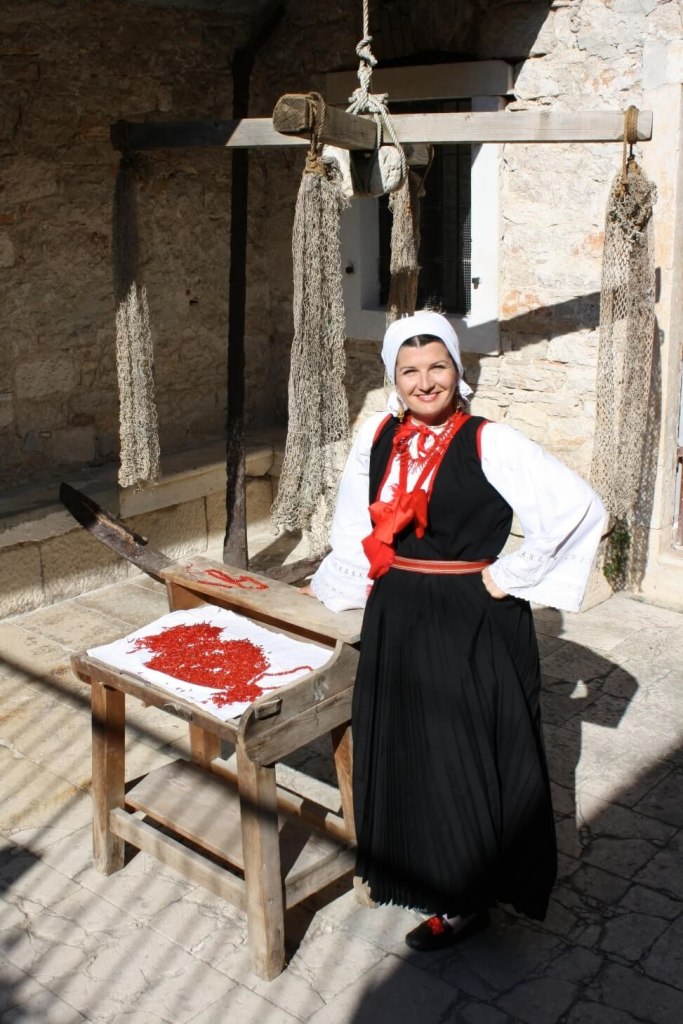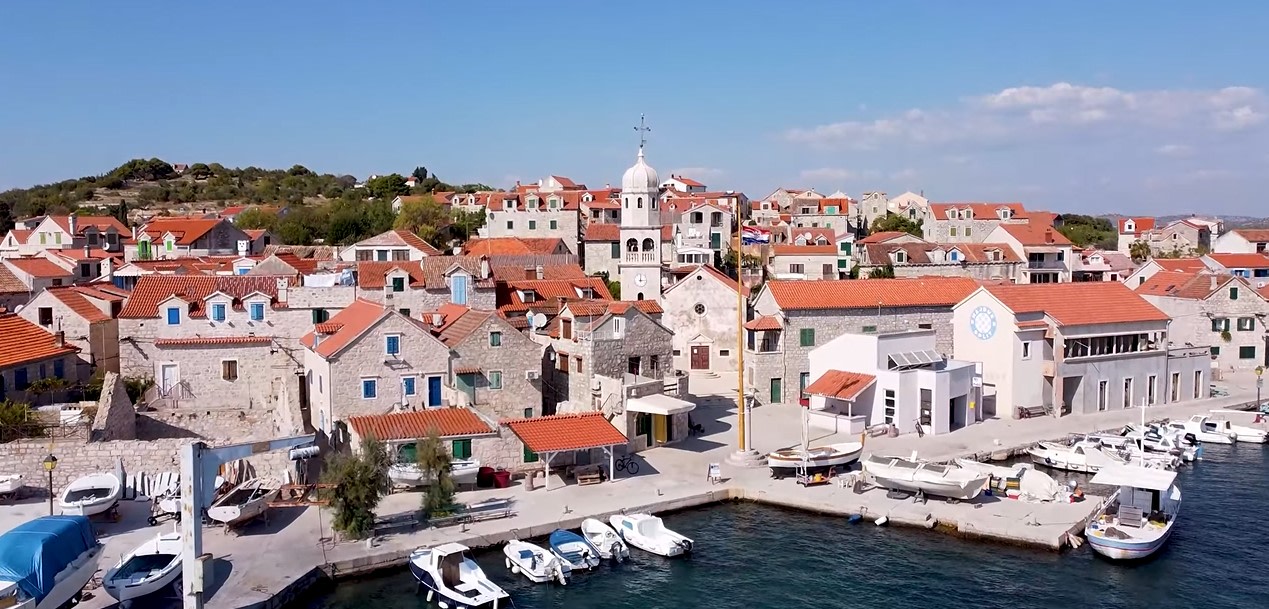Psst … we’ll tell you the course to absolute relaxation
Would you like to escape the city noise and dirty exhaust fumes? Are you also looking for peace and relaxation? Then you’ve come to the right place. We show you the most beautiful car-free islands in Croatia. Take a break from the modern and experience a journey back in time that is guaranteed to awaken nostalgic feelings.
PRVIĆ – THE FIST ISLAND

Prvić is a small island in the Šibenik archipelago. One of the absolute advantages of this small but beautiful island is that there is no car traffic here and never has been. Prvić can be crossed on foot in one day. During the walk, the scent of the sea and the pine forests can be inhaled. Walkers can expect cultivated fields, impressive chapels and natural beaches.
There are two stories about the origin of the name: according to the first, the island was named after the ancient Croatian pagan god of spring and threshing, Prvić or Prvina. The second says that it is so named because it is in the first place (“prvi” = “the first”).
The island is also known for the inventor and renowned humanist Faust Vrančić. Faust recorded his greatest success with the invention of the first functioning parachute and the printed design of his parachute was also the first to be found in technical literature. In 2012, the Faust Vrančić Memorial Centre was opened on the island. Not surprisingly, Prvić is also known as Faust’s Island.
Inhabited since ancient times, Prvić was a summer resort of the Šibenik aristocracy and wealthy citizens and their refuge from the plague in the 17th century. Prvić is part of the town of Vodice and the entire island is protected as a cultural and historical entity.
Prvić in numbers:
- Area: 2.41 km2
- Coast length: 10.6 kilometres
- Population: approx. 400
SILBA – ISLAND OF CONVIVIALITY

West of Zadar is the island of Silba. It was named after the Latin word “silva”, which translated into German means “forest”. The long island did not get its name from somewhere. Silba is the second most forested island in Croatia. Nowadays, the island is known for being car-free. Trolleys are used as a means of transport. It is also home to many houses of famous architectural authors.
At the beginning of summer, you can enjoy the idyll of almost empty beaches coupled with the enchanting scent of herbs, yellow butterflies and lavender. Most of the island’s buildings are on the flat, so you can’t see the coast when you enter the maze of houses. So it’s not surprising that the 15-metre-high lookout point, built in 1872, is the main attraction. The story behind the lookout tower is also delightful: a sailor once promised his lover to build a lookout tower in the garden of her house so that she could climb it to watch his arrivals and departures.
Silba in numbers:
- Area: 14.27 km2
- Coast length: 26.2 kilometres
- Population: 280
DRVENIK VELI – ROBINSON HOLIDAYS

The central Dalmatian island of Drvenik Veliki scores with untouched nature, beautiful beaches, peaceful surroundings, olive trees and vines, and the most sunny days. The coast consists of numerous bays with sandy and pebble beaches. On the southern side of the island is the beautiful Solinska Bay. To the east, there is the village of Krknjaši, also known as the “Blue Lagoon”. The perfect conditions for a quiet and intimate holiday on the Adriatic.
Locals emphasise that on Drvenik Veliki you feel as if you have travelled back in time. It is an island that has so far remained untouched by mass tourism. The few roads that the natural jewel has also remain untravelled. Visitors leave their cars in Trogir. If you are afraid of snakes, we can reassure you. According to locals, there are no snakes on the entire island.
The island is an ideal holiday destination for those who long for a Robinson Crusoe holiday without too much noise and crowds. Only a few restaurants, tavernas and cafés can be counted on the whole island, as well as one shop and one bakery. It is also important to mention that the island is not connected to the water supply.
Drvenik Veli in numbers:
- Area: 12.07 km2
- Coast length: 23.9 kilometres
- Population: 168
UNIJE – ZEN AND JOIE DE VIVRE

Due to its good geo-transportation, water sources and fertile soil, the island has been inhabited throughout the ages. The name of the island most probably comes from the Greek word “(he)neios”, which translates into German as “field”. The island of Unije can be reached by boat from Mali Lošinj or by catamaran line from Rijeka. The main means of transport are tractors. After all, there are no cars on this island either. It is interesting to note, however, that the island has had a small airport since 1996.
According to the 2011 census, the island has a constant population of 88 inhabitants. A peak was recorded in the 90s. At that time, almost 900 people lived on Unije. At that time, there were even two olive mills and a small fish processing factory in operation. A historic event was 7 October 1979, when electricity was introduced to Unije. Hand in hand with this revolution was the start of schooling, the post office and motor transport. As a result, new jobs were created.
If you choose Unije as your next destination, you can either stay in rooms or flats with locals. Characteristic houses with wide gable facades let you experience the Croatian flair at first hand. We also advise you to visit Unije in November, when the Union Squid Festival takes place. This is a competition in squid fishing.
Unije in numbers:
- Area: 17.72 km2
- Coast length: 36.6 kilometres
- Population: 88
SUSAK – THE NATURAL WONDER

The car-free mini-island lies 13 km from Mali Lošnj and delights with one of the most beautiful beaches in the Adriatic. The original name of the island “Sansego” refers to an Italian past. Sansego is also the name of the locally grown wine.
With just under 200 inhabitants, the mini-island even has its own traditional costume. Interesting fact: Susak was much more densely populated until the early 1960s. At that time, about 2,000 Susak people emigrated to America. Many of them still come to their old home on the last Sunday in July to celebrate together.
There are no roads on the island, only kilometre-long dusty paths that invite you to explore secluded bays.
Susak in numbers:
- Area: 3.8 km2
- Coast length: 12 kilometres
- Population: 188
Other islands that are car-free …
- Zlarin is the third largest island in the Šibenik archipelago and the closest to the town of Šibenik. Zlarin is a paradise for children, ideal for an unforgettable holiday experience. You can enjoy a walk in peace of mind or swim in the crystal clear sea. Zlarin is known worldwide for its coral jewellery.
- Lopud is part of the southern Dalmatian archipelago. It is the perfect choice if you want to escape Dubrovnik, which is overcrowded with tourists. Lopud also has one of the most beautiful beaches, Šunj.
- Koločep is located to the west of Dubrovnik. There are no roads here. The only significant road on the island is a concrete road connecting two settlements – Gornje Čelo and Donje Čelo. However, the connecting road is barely wide enough for pedestrians. The two settlements can be reached on foot in 15 minutes.

Yachting on the Croatian Adriatic
Not only are the holiday destinations breathtaking and partly spared from mass tourism, but there is also no need to undertake a nerve-racking journey for unique sailing areas. The Croatian sailing areas are a suitable holiday destination for both experienced boat owners and newcomers to the yachting scene. More information on the current entry requirements for Croatia as well as helpful yachting tips can be found here!
